Smart Project Management: Interactive Platform Using Natural Language Processing Technology
Abstract
1. Introduction
2. Project Management and Performance
3. Applications for Scene Text Detection
4. Expert Interview
- Does your company currently have a management system related to project contracts?
- How do you think that a management system influences your company?
- If there were a change order occurring to anyone of your construction projects, would it make the contract stakeholder(s) not to precisely perform cost control?
- If an interactive platform for stakeholders of a construction contract can be established and carried out, coordination and communication between parties should be improved, benefiting the project. Would you be willing to introduce it? Any other concerns?
5. Mechanism for Contract Keyword Detection Approach
6. Implementation and Discussion
7. Conclusions
Author Contributions
Funding
Institutional Review Board Statement
Informed Consent Statement
Data Availability Statement
Conflicts of Interest
Appendix A
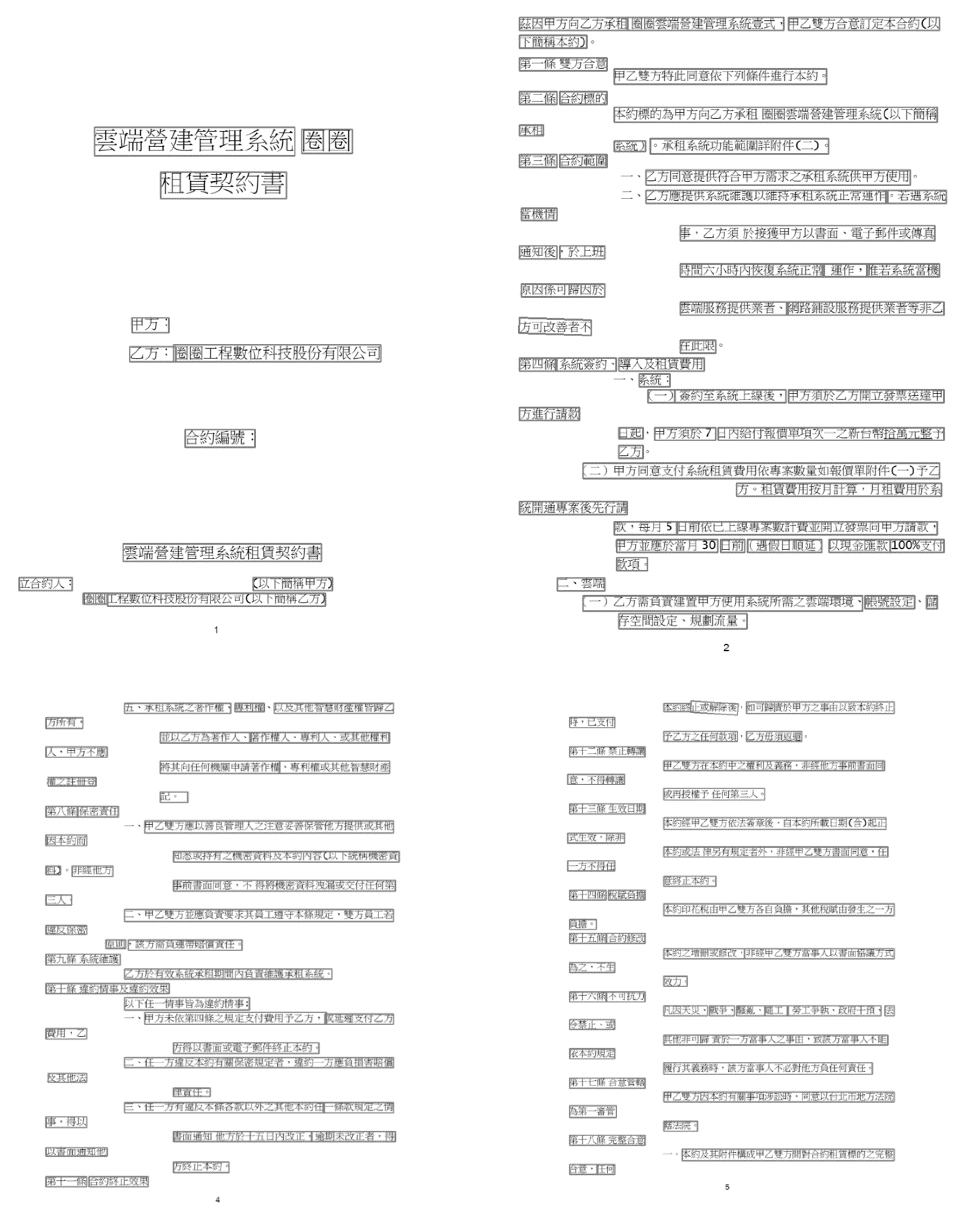
References
- Chen, J.-H.; Nguyen, T.T.H.; Tai, H.W.; Chang, C.A. The willingness to adopt the Internet of Things (IoT) conception in Taiwan’s construction industry. J. Civ. Eng. Manag. 2020, 26, 534–550. [Google Scholar] [CrossRef]
- Shahhosseini, V.; Sebt, M.H. Competency-based selection and assignment of human resources to construction projects. Sci. Iran. 2011, 18, 163–180. [Google Scholar] [CrossRef]
- Ibrahim, M.W.; Hanna, A.; Kievet, D. Quantitative comparison of project performance between project delivery systems. Asce J. Manag. Eng. 2020, 36, 04020082. [Google Scholar] [CrossRef]
- Ji, T.; Chen, J.-H.; Wei, H.-H.; Su, Y.-C. Towards people-centric smart city development: Investigating the citizens’ preferences and perceptions about smart-city services in Taiwan. Sustain. Cities Soc. 2021, 67, 102691. [Google Scholar] [CrossRef]
- Chen, J.-H.; Hsu, S.-C.; Wang, R.; Chou, H.-A. Improving hedging decision for financial risks of construction material suppliers using grey system theory. Asce J. Manag. Eng. 2017, 33, 04017016. [Google Scholar] [CrossRef]
- Yang, L.-R.; Chen, J.-H.; Wang, X.-L. Assessing the effect of requirements definition and management on performance outcomes: Role of interpersonal conflict, product advantage and project type. Int. J. Proj. Manag. 2015, 33, 67–80. [Google Scholar] [CrossRef]
- Yeh, H.-H.; Hsieh, T.-Y.; Chen, J.-H.; Peng, H.-T. Preventive interface management for design-build wireless train control mass rapid transit projects. ASCE J. Perform. Constr. Facil. 2019, 34, 06019004. [Google Scholar] [CrossRef]
- Lu, C.; Yu, Z.W.; Wang, X.T.; Hong, Y.M. Empirical study on the obstacles to the success of joint ventures in construction projects. Adv. Civ. Eng. 2020, 2020, 1748198. [Google Scholar] [CrossRef]
- Khattak, M.S.; Mustafa, U. Management competencies, complexities and performance in engineering infrastructure projects of Pakistan. Eng. Constr. Archit. Manag. 2019, 26, 1321–1347. [Google Scholar] [CrossRef]
- Wang, T.-K.; Gu, X.; Li, K.; Chen, J.-H. Competitive location selection of a commercial center based on the vitality of commercial districts and residential motion. J. Urban Plan. Dev. 2021, 147, 04021001. [Google Scholar] [CrossRef]
- Wang, R.; Lee, C.-J.; Hsu, S.-C.; Chen, J.-H. Preventing or encouraging illegal activities by construction firms: The effects of top management team compensation and aspiration-performance discrepancies. Eng. Constr. Archit. Manag. 2021. Accepted. [Google Scholar] [CrossRef]
- Cheung, S.O.; Chow, P.T.; Tse, J.K.M. Performance of mediator tactics in building management disputes. ASCE J. Manag. Eng. 2015, 31, 04014033. [Google Scholar] [CrossRef]
- Mahfouz, T.; Kandil, A. Litigation outcome prediction of differing site condition disputes through machine learning models. ASCE J. Comput. Civ. Eng. 2012, 35, 298–308. [Google Scholar] [CrossRef]
- Hsu, K.-M.; Hsieh, T.-Y.; Chen, J.-H. Resolution toward the disputes caused by trial operation for construction projects. Int. J. Organ. Innov. 2019, 12, 375–388. [Google Scholar]
- Li, H.; Lalla-Ruiz, E.; Vo, S. Modeling and solving cloud service purchasing in multi-cloud environments. Expert Syst. Appl. 2020, 147, 113165. [Google Scholar]
- Wang, Y.; Hong, K.; Zou, J.; Peng, T.; Yang, H.A. CNN-based visual sorting system with cloud-edge computing for flexible manufacturing systems. Ieee Trans. Ind. Inform. 2019, 16, 4726–4735. [Google Scholar] [CrossRef]
- Wu, I.; Liu, C.-C. A visual and persuasive energy conservation system based on BIM and IoT technology. Sensors 2020, 20, 139. [Google Scholar] [CrossRef]
- Project Management Institution. A Guide to the Project Management Body of Knowledge (PMBOK Guide); Project Management Institution: Newtown Square, PA, USA, 2017. [Google Scholar]
- Papic, L. Special issue: Current research in life cycle engineering and management. Int. J. Syst. Assur. Eng. Manag. 2019, 10, 1–2. [Google Scholar] [CrossRef]
- Fuller, S.K.; Petersen, S.R. Life-Cycle Costing Manual for the Federal Energy Management Program; Handbook: New York, NY, USA, 1996. [Google Scholar]
- Anantatmula, V. Project manager leadership role in improving project performance. Eng. Manag. J. 2010, 22, 13–22. [Google Scholar] [CrossRef]
- Tian, Z.; Huang, W.; He, T.; He, P.; Qiao, Y. Detecting text in natural image with connectionist text proposal network. In Proceedings of the European Conference on Computer Vision (ECCV), Amsterdam, The Netherlands, 8–16 October 2016. [Google Scholar]
- Ren, S.; He, K.; Girshick, R.; Sun, J. Faster r-cnn: Towards real-time object detection with region proposal networks. IEEE Trans. Pattern Anal. Mach. Intell. 2016, 39, 1137–1149. [Google Scholar] [CrossRef] [PubMed]
- Shi, B.; Bai, X.; Belongie, S. Detecting oriented text in natural images by linking segments. In Proceedings of the IEEE Conference on Computer Vision and Pattern Recognition (CVPR), Honolulu, HI, USA, 21–26 July 2017. [Google Scholar]
- Zhou, X.; Yao, C.; Wen, H.; Wang, Y.; Zhou, S.; He, W. East: An efficient and accurate scene text detector. In Proceedings of the IEEE conference on Computer Vision and Pattern Recognition (CVPR), Honolulu, HI, USA, 21–26 July 2017. [Google Scholar]
- Jaderberg, M.; Simonyan, K.; Vedaldi, A.; Zisserman, A. Reading text in the wild with convolutional neural networks. Intern. J. Comput Vis. 2016, 116, 1–20. [Google Scholar] [CrossRef]
- Zhang, Z.; Zhang, C.; Shen, W.; Yao, C.; Liu, W.; Bai, X. Multi-oriented text detection with fully convolutional networks. In Proceedings of the IEEE Conference on Computer Vision and Pattern Recognition (CVPR), Las Vegas, NV, USA, 26 June–1 July 2016. [Google Scholar]
- Long, J.; Shelhamer, E.; Darrell, T. Fully convolutional networks for semantic segmentation. In Proceedings of the IEEE Conference on Computer Vision and Pattern Recognition (CVPR), Boston, MA, USA, 7–12 June 2015. [Google Scholar]
- Kim, K.-H.; Hong, S.; Roh, B.; Cheon, Y.; Park, M. PVANET: Deep but lightweight neural networks for real-time object detection. In Proceedings of the IEEE Conference on Computer Vision and Pattern Recognition (CVPR), Las Vegas, NV, USA, 26 June–1 July 2016. [Google Scholar]
- Ronneberger, O.; Fischer, P.; Brox, T. U-net: Convolutional networks for biomedical image segmentation. In Proceedings of the International Conference on Medical Image Computing and Computer-Assisted Intervention, Munich, Germany, 4–8 October 2015. [Google Scholar]
- Wang, W.; Xie, E.; Li, X.; Hou, W.; Lu, T.; Yu, G. Shape robust text detection with progressive scale expansion network. In Proceedings of the IEEE Conference on Computer Vision and Pattern Recognition (CVPR), Long Beach, NY, USA, 16–20 June 2019. [Google Scholar]
- Lin, T.-Y.; Dollár, P.; Girshick, R.; He, K.; Hariharan, B.; Belongie, S. Feature pyramid networks for object detection. In Proceedings of the IEEE Conference on Computer Vision and Pattern Recognition (CVPR), Honolulu, HI, USA, 21–26 July 2017. [Google Scholar]
- Baker, S.E.; Rosalind, E. How Many Qualitative Interviews is Enough? Expert Voices and Early Career Reflections on Sampling and Cases in Qualitative Research; University of Southampton Institutional Repository: Southampton, UK, 2012. [Google Scholar]
- Guest, G.; Bunce, A.; Johnson, L. How Many Interviews Are Enough? An Experiment with Data Saturation and Variability; Sage Publications: Newbury Park, CA, USA, 2006. [Google Scholar]
- Poleacovschi, C.; Javernick-Will, A. Who are the experts? Assessing expertise in construction and engineering organizations. Asce J. Constr. Eng. Manag. 2017, 143, 04017033. [Google Scholar] [CrossRef]
- Nadeau, D.; Sekine, S. A survey of named entity recognition and classification. Lingvisticae Investig. 2007, 30, 3–26. [Google Scholar] [CrossRef]


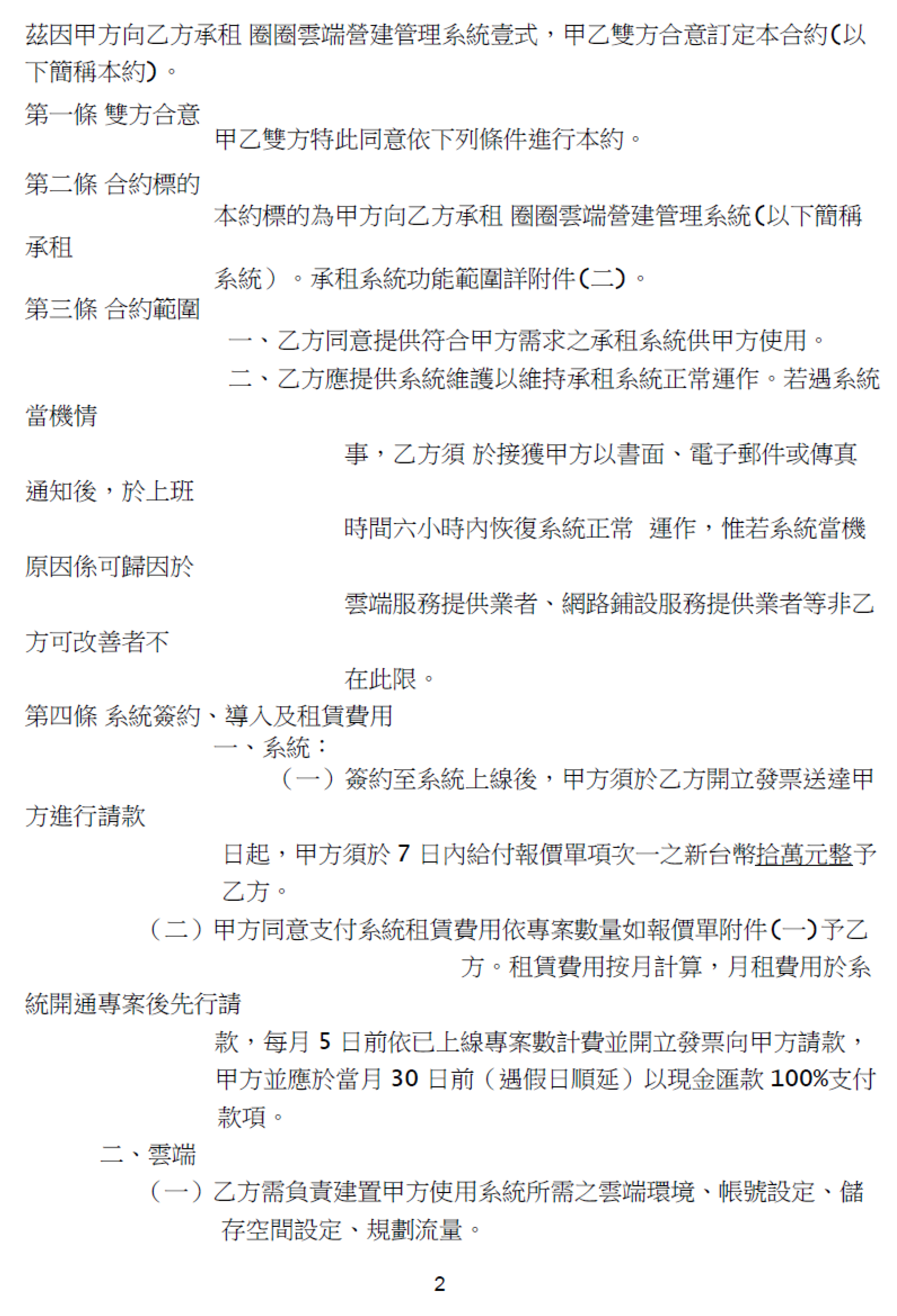
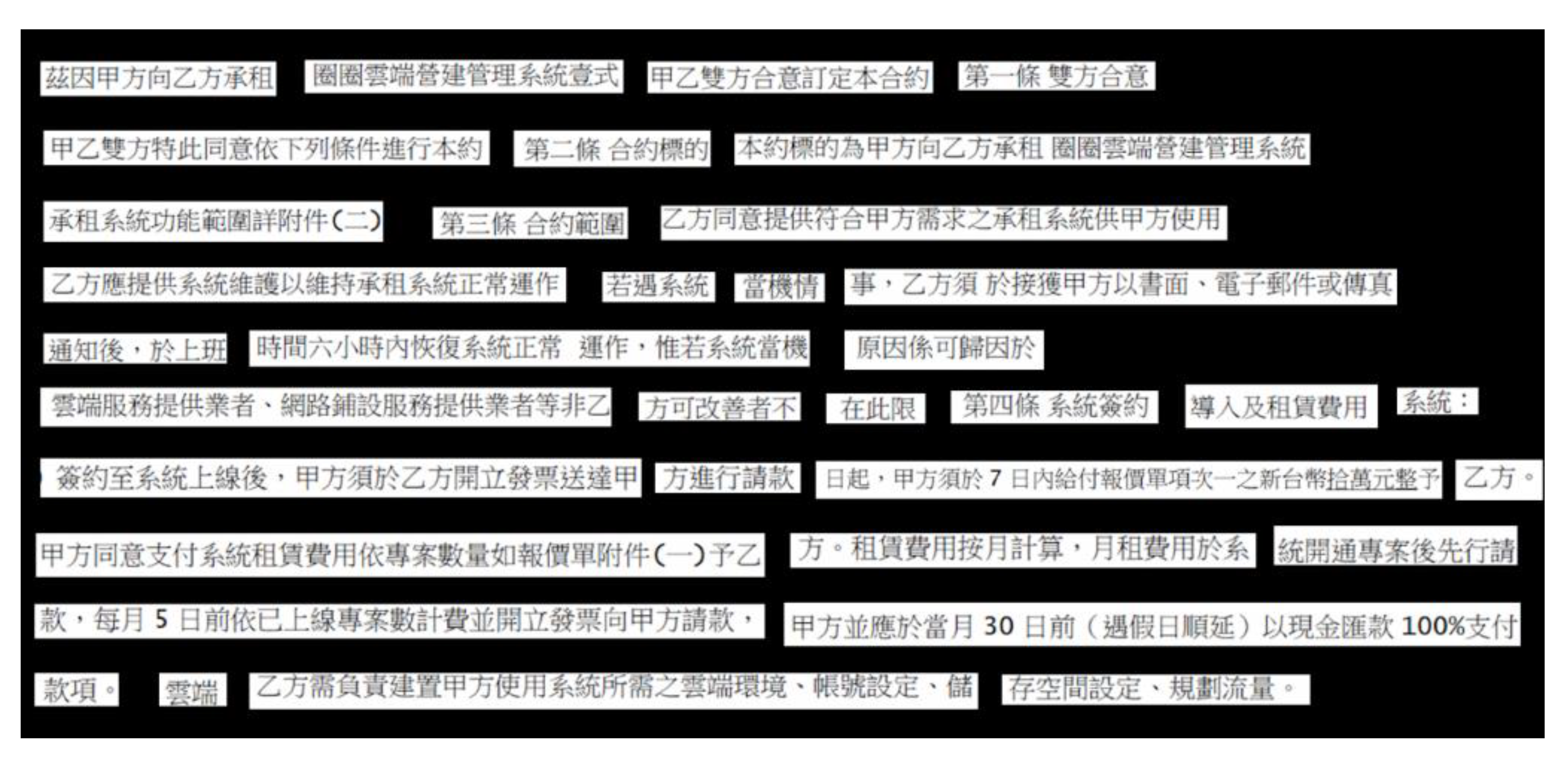
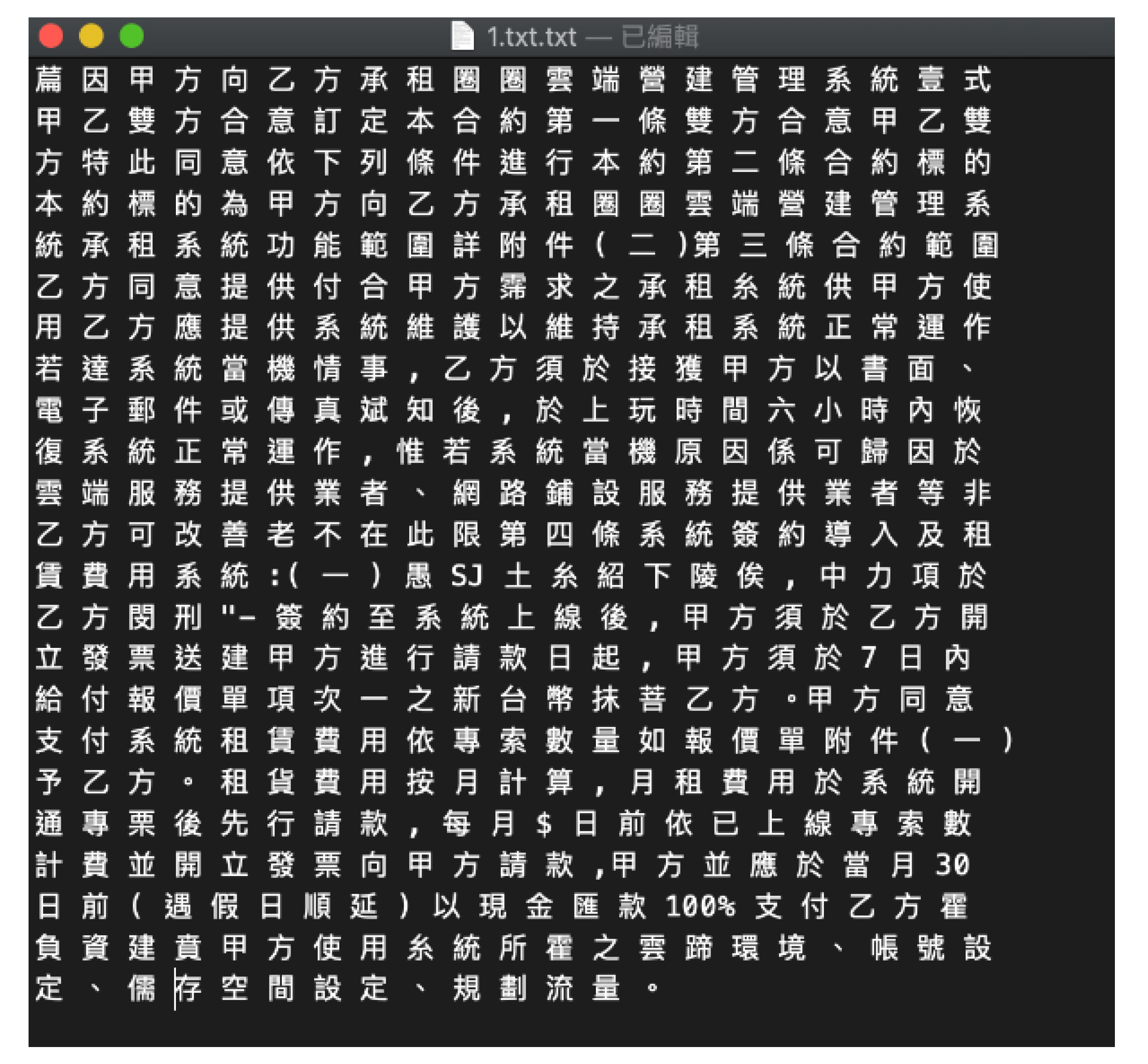
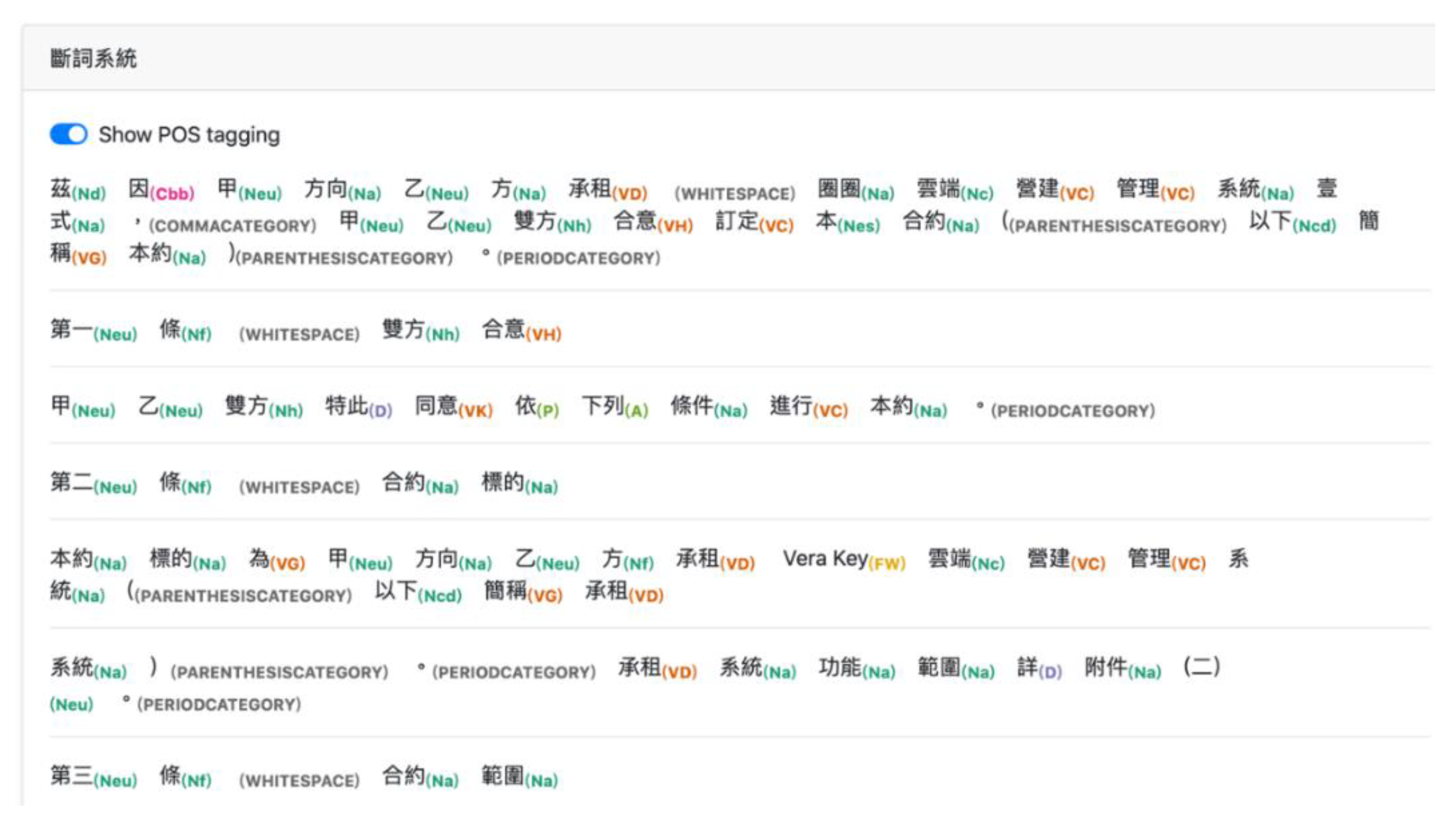
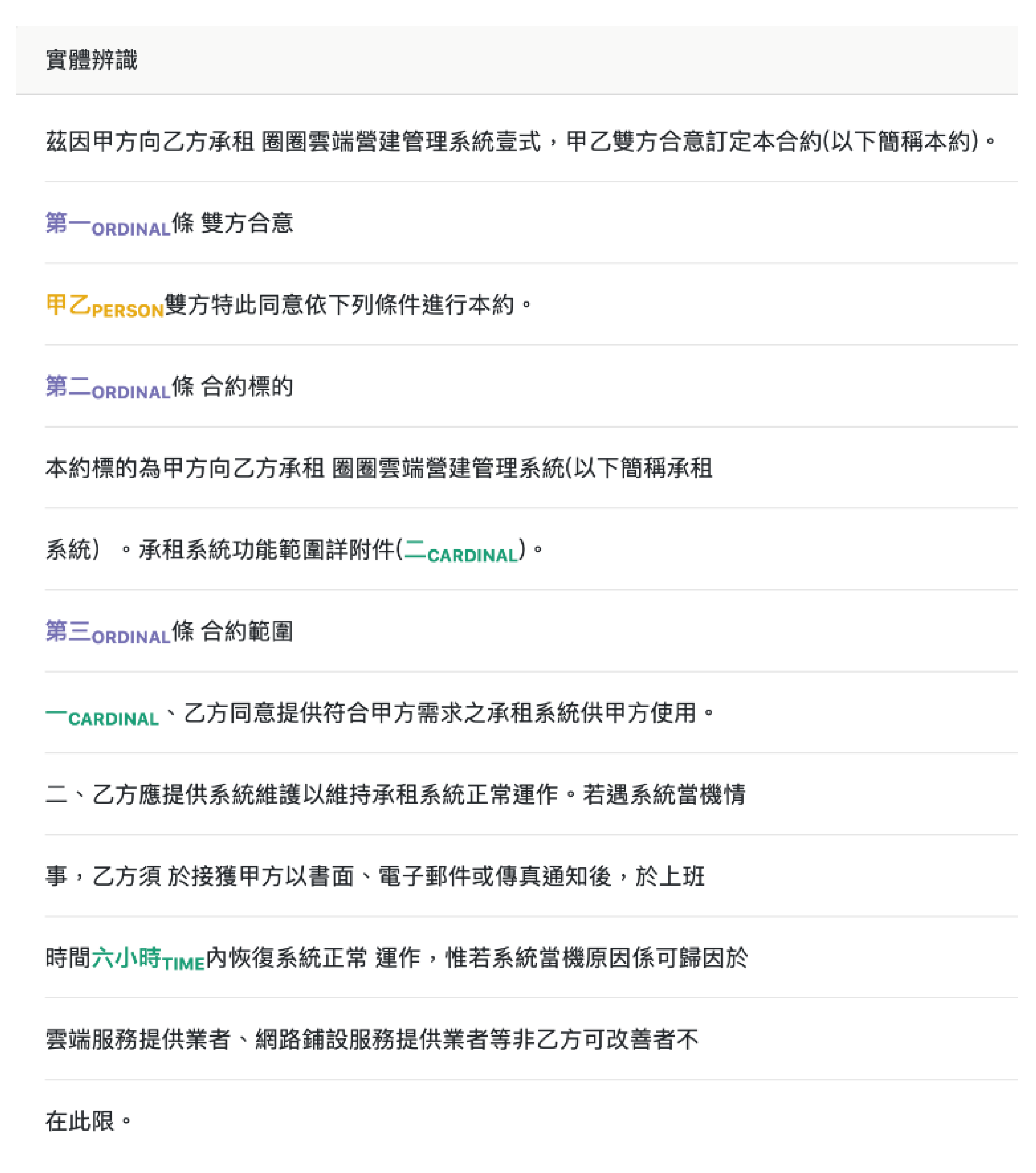
| Speech Code | Explanation | Speech Code | Explanation |
|---|---|---|---|
| A | Non-predicative adjective | Caa | Peer conjunction |
| Cab | Conjunctions, such as: etc. | Cba | Conjunctions, such as: if |
| Cbb | Related connectives | D | Adverb |
| Da | Adverbs of quantity | Dfa | Pre-verb adverb |
| Dfb | Post-verb adverb | Di | Tense mark |
| Dk | Sentence adverbs | DM | Quantitative |
| I | Interjection | Na | Common noun |
| Nb | Proper noun | Nc | Local word |
| Ncd | Position word | Nd | Time word |
| Nep | Referent | Neqa | Quantifier |
| Neqb | Post-quantifier | Nes | Specific word |
| Neu | Numeral attributive | Nf | Quantifier |
| Ng | Postposition | Nh | Synonym |
| Nv | Nominalized verb | P | Preposition |
| T | Particle | VA | Intransitive verb |
| VAC | Action verb | VB | Action and transitive verbs |
| VC | Transitive verb action | VCL | Action-to-local object verb |
| VD | Double object verb | VF | Action predicate verb |
| VE | Object verb | VG | Categorical verb |
| VH | Intransitive verb | VHC | State-verb |
| VI | Transitive verb | VJ | Transitive verb |
| VK | Object verb | VL | State predicate verb |
| V_2 | Have | DE | Place of gain |
| COLONCATEGORY | Colon | COMMACATEGORY | Comma |
| DASHCATEGORY | Dash | DOTCATEGORY | Dot |
| ETCCATEGORY | Truncation number | EXCLAMATIONCATEGORY | Exclamation point |
| PARENTHESISCATEGORY | Brackets | PAUSECATEGORY | Comma |
| PERIODCATEGORY | Period | QUESTIONCATEGORY | Question mark |
| SEMICOLONCATEGORY | Semicolon | SPCHANGECATEGORY | Dual straight line |
| WHITESPACE | Blank |
Publisher’s Note: MDPI stays neutral with regard to jurisdictional claims in published maps and institutional affiliations. |
© 2021 by the authors. Licensee MDPI, Basel, Switzerland. This article is an open access article distributed under the terms and conditions of the Creative Commons Attribution (CC BY) license (http://creativecommons.org/licenses/by/4.0/).
Share and Cite
Chen, J.-H.; Su, M.-C.; Azzizi, V.T.; Wang, T.-K.; Lin, W.-J. Smart Project Management: Interactive Platform Using Natural Language Processing Technology. Appl. Sci. 2021, 11, 1597. https://doi.org/10.3390/app11041597
Chen J-H, Su M-C, Azzizi VT, Wang T-K, Lin W-J. Smart Project Management: Interactive Platform Using Natural Language Processing Technology. Applied Sciences. 2021; 11(4):1597. https://doi.org/10.3390/app11041597
Chicago/Turabian StyleChen, Jieh-Haur, Mu-Chun Su, Vidya Trisandini Azzizi, Ting-Kwei Wang, and Wei-Jen Lin. 2021. "Smart Project Management: Interactive Platform Using Natural Language Processing Technology" Applied Sciences 11, no. 4: 1597. https://doi.org/10.3390/app11041597
APA StyleChen, J.-H., Su, M.-C., Azzizi, V. T., Wang, T.-K., & Lin, W.-J. (2021). Smart Project Management: Interactive Platform Using Natural Language Processing Technology. Applied Sciences, 11(4), 1597. https://doi.org/10.3390/app11041597








